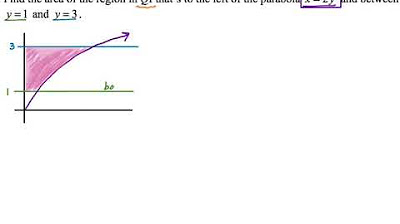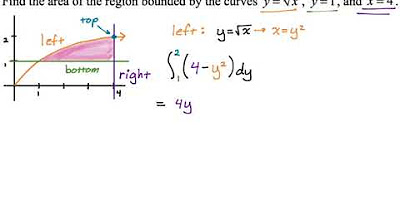Area between a curve and and the _-axis | AP Calculus AB | Khan Academy
TLDRIn this instructional video, the focus is on calculating the area between the curve y=15/x and the y-axis, bounded by y=e and y=e^3. The instructor adeptly demonstrates how to approach this problem by treating it as a definite integral, cleverly switching the perspective from the x-axis to the y-axis. By rewriting the function in terms of x as 15/y, the instructor guides the viewer through the process of evaluating the integral, using the antiderivative of 1/y to find the natural log of the absolute value of y. The final calculation involves evaluating the natural log at the bounds, resulting in a simple and elegant solution of 15 times the difference between the natural logs of e and e^3.
Takeaways
- 📈 The video discusses finding the area between a curve and the y-axis, bounded by two y-values, rather than the traditional x-values.
- 🔢 The function in question is y = 15/x, and the focus is on the positive values of x.
- 📌 The bounds for the area calculation are y = e (bottom bound) and y = e^3 (upper bound).
- 🌀 The problem is approached by rewriting the function in terms of x, resulting in x = 15/y.
- 🖼️ The concept of estimating area using rectangles with width 15/y and height dy is introduced.
- 🧩 The area is found by summing these rectangles from y = e to y = e^3, similar to the process for definite integrals.
- 📚 The antiderivative of 15/y is used to calculate the area, which is 15 times the natural log of the absolute value of y.
- 📈 The area calculation involves evaluating the natural log function at the endpoints y = e^3 and y = e.
- 🔢 The final result is obtained by calculating 15 times the difference of the natural logs of e^3 and e, which simplifies to 15 times 3 - 15, resulting in 30 - 15.
- 🎓 The video is an educational resource for understanding the concept of definite integrals and their application in different scenarios.
- 👍 The method demonstrated is a practical approach to problem-solving in calculus, showcasing the flexibility in applying the fundamental concepts.
Q & A
What is the function represented by the graph in the video?
-The function represented by the graph is y = 15/x, for positive values of x.
What is the unique aspect of the area being calculated in this video?
-The unique aspect is that the area is bounded by two y-values, rather than two x-values, with the curve and the y-axis.
How is the function y = 15/x rewritten in terms of x?
-By multiplying both sides of the equation by x, we get xy = 15, and dividing both sides by y, we get x = 15/y.
What is the method used to estimate the area under the curve in this video?
-The method used is similar to the concept of definite integrals, but instead of rectangles under the x-axis, we have rectangles along the y-axis with width 15/y and height dy.
What is the width of each rectangle in the estimation of the area?
-The width of each rectangle is 15/y, where y is the value on the y-axis.
What is the height of each rectangle in the estimation of the area?
-The height of each rectangle is a very small change in y, denoted as dy.
What is the integral expression used to calculate the area between the curve and the y-axis?
-The integral expression is ∫(15/y dy) from y=e to y=e^3.
What is the antiderivative of 15/y?
-The antiderivative of 15/y is 15 times the natural logarithm of the absolute value of y, or 15 ln|y|.
How is the area calculated using the antiderivative and the bounds y=e and y=e^3?
-The area is calculated by evaluating 15 ln|y| at the upper bound e^3 and subtracting the value at the lower bound e, which simplifies to 15(3 - 1) = 30.
What is the final result of the area calculation?
-The final result of the area calculation is 15 units squared, as 30 - 15 = 15.
How does this video demonstrate the flexibility of integral calculus?
-This video demonstrates the flexibility of integral calculus by showing how it can be applied to find areas in non-standard configurations, such as being bounded by y-values instead of x-values.
Outlines
📊 Understanding Area Calculation with Integrals
The instructor introduces the concept of finding the area between a curve defined by the function y = 15/x and the y-axis, as opposed to the conventional approach of finding the area between a curve and the x-axis. This unique scenario involves calculating the area bounded by y-values, specifically between y = e and y = e^3. The method involves redefining the function in terms of y, leading to x = 15/y, which facilitates the calculation of the area of small rectangles that approximate the area under the curve when summed. The instructor then guides through the process of setting up and evaluating the definite integral from y = e to y = e^3, which involves integrating 15/y with respect to y. The evaluation reveals that the total area under the curve, between the specified bounds, is 45 minus 15, resulting in a total area of 30.
Mindmap
Keywords
💡Graph
💡Function
💡Area
💡Definite Integral
💡Antiderivivative
💡Natural Logarithm
💡Bounds
💡Rectangles
💡dy
💡e
💡e to the third power
Highlights
The graph of the function y equals 15 over x is discussed, focusing on positive values of x.
The main goal is to find the area between the curve and the y-axis, bounded by y values of e and e to the third power.
The problem is analogous to finding areas under a curve with respect to the x-axis, but the focus is on the y-axis.
The function y equals 15 over x is rewritten in terms of x as xy equals 15, and x equals 15 over y.
The area estimation involves considering a series of rectangles, with width x (expressed as 15 over y) and height dy.
The area of each small rectangle is given by 15 over y times dy.
The definite integral sums the areas of these rectangles from y equals e to y equals e to the third power.
The antiderivative of 15 over y is 15 times the natural log of the absolute value of y.
The area is evaluated by finding the difference between the natural log of e to the third power and the natural log of e.
The natural log of e to the third power simplifies to three times the natural log of e.
The final calculation results in 15 times the difference between 3 (the exponent for e to the third power) and 1 (the exponent for e), which is 30 minus 15.
The result of the area calculation is 15 times the difference, leading to the final answer of 45 minus 15.
The problem-solving process demonstrates the application of definite integrals in calculating areas with unconventional bounds.
The explanation provides a clear and detailed walkthrough of the mathematical steps, making it accessible for learners.
The use of the natural log function and properties of exponents is a key aspect of solving this type of problem.
The video serves as an educational resource for understanding the concept of definite integrals and their application beyond the standard bounds.
Transcripts
Browse More Related Video

Area Between Curves: Integrating with Respect to y (Example 2)

Disc method around y-axis | Applications of definite integrals | AP Calculus AB | Khan Academy

Volume with cross sections perpendicular to y-axis | AP Calculus AB | Khan Academy

Area Between Curves: Integrating with Respect to y (Example 1)

2022 AP Calculus BC Exam FRQ #5

Area Between Curves: Integrating with Respect to y (Example 3)
5.0 / 5 (0 votes)
Thanks for rating: